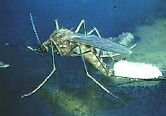 A service of the U.S. National Library of Medicine
A service of the U.S. National Library of Medicine  National Institutes of Health
National Institutes of Health

West Nile Cases Keep Climbing; 118 Deaths So Far, CDC Says

WEDNESDAY, Sept. 12 (HealthDay News) -- One of the worst outbreaks of West Nile virus ever to strike the United States has yet to subside, with a new total of 2,636 cases and 118 deaths, federal health officials reported Wednesday.
While all states except Alaska and Hawaii have reported at least one case of West Nile virus, two-thirds of the cases have been reported from six states -- Texas, Louisiana, South Dakota, Mississippi, Michigan and Oklahoma. The latest statistics reflect cases reported as of Tuesday.
In a Wednesday press briefing, officials from the U.S. Centers for Disease Control and Prevention said the outbreak is most widespread in Texas, where 40 percent of the total U.S. cases have been reported.
This year's outbreak is on track to be the deadliness outbreak of West Nile since the virus was identified in 1999, Dr. Lyle Petersen, director of CDC's Division of Vector-Borne Infectious Diseases, said during the briefing. "The number of people reported with West Nile disease continues to go up, and we expect the numbers will be high at least until October," he added.
However, "one good piece of news is, based on historical data, we have turned the corner on the epidemic," Petersen said. "Experience has shown us that West Nile outbreaks in the United States tend to peak in mid- to late August. So, we are hopeful the worst of the outbreak is behind us."
As of Tuesday, 1,405 (53 percent) of cases were classified as neuroinvasive disease (such as meningitis or encephalitis) while 1,231 (47 percent) were classified as non-neuroinvasive disease.
The 2,636 cases reported thus far in 2012 is the highest number of West Nile virus disease cases reported to CDC through the second week in September since 2003, the agency said.
And those numbers may only be the tip of the iceberg, Petersen stressed. The total number people infected with West Nile is much higher then these numbers reflect, since only 2 percent to 3 percent of West Nile fever cases (non-neuroinvasive) are reported, he said.
The reasons for the outbreak this year aren't clear. A drought in Texas may have played a role, but there are probably other factors as well, officials said.
The best way to avoid the virus is to wear insect repellant and support local programs to eradicate mosquitoes, Petersen said.
There is currently no treatment for West Nile virus and no vaccine to prevent it, he added.
Speaking last week to reporters, Dr. David Lakey, commissioner of the Texas Department of State Health Services, said health officials in his state "continue to be very concerned about the West Nile outbreak we are seeing."
"Historically, August is the peak but this year has been unpredictable, the virus has been unpredictable and we have a large number of cases," he said, adding "2012 is now officially our worst year for West Nile."
Generally speaking, 80 percent of people who are infected with West Nile virus develop no or few symptoms, while 20 percent develop mild symptoms such as headache, joint pain, fever, skin rash and swollen lymph glands, according to the CDC.
People older than 50 and those with certain medical conditions, such as cancer, diabetes, hypertension, kidney disease and organ transplants, are at greater risk for serious illness.
There are no specific treatments for West Nile virus.
Although most people with mild cases of West Nile virus will recover on their own, the CDC recommends that anyone who develops symptoms should see their doctor right away. The best way to protect yourself from West Nile virus is to avoid getting bitten by mosquitoes, which can pick up the disease from infected birds. The CDC recommends the following steps to protect yourself:
- Use insect repellents when outside.
- Wear long sleeves and pants from dawn to dusk.
- Don't leave standing water outside in open containers, such as flowerpots, buckets and kiddie pools.
- Install or repair windows and door screens.
- Use air conditioning when possible.
SOURCES: Sept. 12, 2012, press conference with Lyle R. Petersen, M.D., M.P.H., director, Division of Vector-Borne Infectious Diseases, U.S. Centers for Disease Control and Prevention; Sept. 5, 2012, press conference with David L. Lakey, M.D., Commissioner, Texas Department of State Health Services
- More Health News on:
- Health Statistics
- West Nile Virus